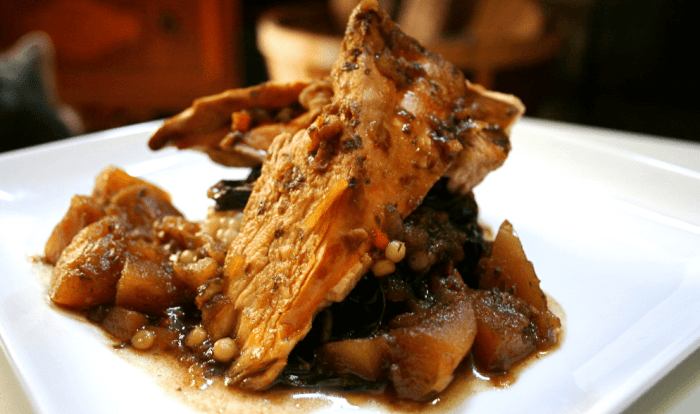
Embark on a culinary adventure with our comprehensive guide to chicken of the woods recipe. From foraging techniques to tantalizing variations, we’ll explore the versatility of this wild mushroom and inspire you to create unforgettable dishes.
As we delve into the world of chicken of the woods, we’ll uncover its nutritional value, optimal cooking methods, and the secrets to preserving its unique flavor and texture.
Ingredient Overview

Chicken of the woods is a polypore mushroom that can be found in forests around the world. It is a popular edible mushroom due to its meaty texture and flavor. There are several different types of chicken of the woods, each with its own distinct characteristics.
- Sulphur Shelf (Laetiporus sulphureus): This is the most common type of chicken of the woods. It has a bright orange to yellow color and grows in clusters on the sides of trees.
- False Chicken of the Woods (Laetiporus huroniensis): This mushroom is similar to the sulphur shelf, but it has a more muted orange color and grows in smaller clusters.
- Golden Chicken of the Woods (Laetiporus gilbertsonii): This mushroom has a bright yellow color and grows in large clusters on the sides of trees.
In addition to the above, you will also need the following ingredients:
- 1 tablespoon olive oil
- 1 onion, chopped
- 2 cloves garlic, minced
- 1 cup vegetable broth
- 1/2 cup white wine (optional)
- 1 tablespoon soy sauce
- 1 teaspoon dried thyme
- 1/2 teaspoon salt
- 1/4 teaspoon black pepper
Chicken of the woods is a good source of protein, fiber, and vitamins. It is also low in calories and fat. Some studies have shown that chicken of the woods may have antioxidant and anti-inflammatory properties.
Preparation Methods

Chicken of the woods is a versatile mushroom that can be prepared in various ways, each offering a unique flavor and texture. Whether you’re a seasoned cook or a beginner, here’s a comprehensive guide to the most popular preparation methods, ensuring you get the best out of this delectable delicacy.
Sautéing
Sautéing is a quick and easy method that allows you to preserve the mushroom’s delicate flavor. Heat a skillet over medium heat, add a knob of butter or a drizzle of olive oil, and gently sauté the chicken of the woods until golden brown, about 5-7 minutes.
Season with salt and pepper to taste.
Grilling
Grilling imparts a smoky flavor to the mushroom, perfect for summer gatherings. Preheat your grill to medium-high heat, brush the chicken of the woods with olive oil, and grill for 5-7 minutes per side, or until tender and slightly charred.
Serve with a squeeze of lemon juice and a sprinkle of fresh herbs.
Roasting
Roasting is a great way to caramelize the chicken of the woods, bringing out its natural sweetness. Preheat your oven to 400°F (200°C), toss the mushroom with olive oil, salt, and pepper, and roast for 15-20 minutes, or until tender and golden brown.
Serve as a side dish or as a topping for pizzas and salads.
Recipe Variations

Chicken of the woods is a versatile ingredient that can be prepared in various ways. Different recipes showcase its unique flavor and texture, catering to diverse dietary preferences and taste profiles.
The table below compares popular chicken of the woods recipes, highlighting their ingredients, cooking methods, and flavor profiles:
| Recipe | Ingredients | Cooking Method | Flavor Profile |
|---|---|---|---|
| Sautéed Chicken of the Woods | Chicken of the woods, butter, garlic, herbs | Sautéing | Savory, earthy, with hints of garlic and herbs |
| Roasted Chicken of the Woods | Chicken of the woods, olive oil, salt, pepper | Roasting | Slightly crispy exterior, tender interior, with roasted flavors |
| Chicken of the Woods Tacos | Chicken of the woods, tortillas, beans, salsa | Grilling or sautéing | Bold, savory, with a hint of Mexican spices |
| Chicken of the Woods Soup | Chicken of the woods, vegetables, broth | Simmering | Rich, hearty, with a depth of flavor from the vegetables |
| Vegan Chicken of the Woods | Chicken of the woods, tofu, vegetable broth | Sautéing or roasting | Meat-like texture, with a subtle chicken-like flavor |
In addition to these classic recipes, chicken of the woods can also be incorporated into vegetarian and gluten-free dishes. For example, it can be added to stir-fries, curries, or pasta dishes.
The unique flavor of chicken of the woods pairs well with a variety of accompaniments. Roasted vegetables, mashed potatoes, or creamy sauces complement its earthy taste. For a more complex flavor profile, try pairing it with strong cheeses, such as blue cheese or cheddar.
Culinary Applications: Chicken Of The Woods Recipe
Chicken of the woods is a highly versatile mushroom that can be incorporated into a wide range of culinary applications. Its unique flavor and texture make it an excellent addition to soups, stews, salads, and main courses.
One of the most popular ways to enjoy chicken of the woods is to sauté it with butter or oil. This simple preparation method allows the mushroom’s natural flavors to shine through. Sautéed chicken of the woods can be served as a side dish or added to pasta dishes, pizzas, or omelets.
As a Meat Substitute
Chicken of the woods can also be used as a meat substitute in vegetarian and vegan dishes. Its meaty texture and umami flavor make it an excellent choice for replacing ground beef or chicken in recipes. For example, chicken of the woods can be used to make vegetarian tacos, burgers, or meatballs.
In Soups and Stews, Chicken of the woods recipe
Chicken of the woods adds a rich, earthy flavor to soups and stews. It can be added to soups at any stage of the cooking process, but it is best to add it towards the end so that it does not overcook and become tough.
In Salads
Chicken of the woods can be added to salads for a boost of flavor and texture. It can be cooked and added to salads warm or cold. Chicken of the woods can also be used to make a flavorful salad dressing.
Foraging and Sustainability
Foraging for chicken of the woods in the wild can be an exciting experience, but it’s crucial to do so safely and sustainably to preserve the mushroom’s habitat and promote biodiversity.
Before venturing out, familiarize yourself with the mushroom’s characteristics and potential lookalikes. Always harvest from healthy, young specimens and leave the base intact to allow for regrowth. Avoid foraging in areas with heavy foot traffic, pollution, or pesticide use.
Sustainable Foraging Practices
- Identify mushrooms accurately before harvesting.
- Harvest only what you need and leave plenty behind for others and wildlife.
- Cut the mushroom at the base, leaving the root intact for regrowth.
- Avoid foraging in heavily trafficked or polluted areas.
- Respect the natural habitat and leave it undisturbed.
Environmental Benefits of Consuming Wild Mushrooms
Consuming wild mushrooms, including chicken of the woods, offers several environmental benefits. Wild mushrooms play a vital role in nutrient cycling, breaking down organic matter and releasing essential nutrients back into the soil. They also form symbiotic relationships with trees, aiding in water and nutrient absorption.
By consuming wild mushrooms, we support these natural processes and contribute to the overall health of forest ecosystems.
Moreover, foraging for wild mushrooms promotes biodiversity by encouraging people to explore natural areas and appreciate the interconnectedness of the environment. It also reduces our reliance on cultivated mushrooms, which require significant resources and energy to produce.
Final Conclusion
Whether you’re a seasoned forager or a culinary novice, our chicken of the woods recipe guide empowers you to harness the wonders of this wild delicacy. Embrace the sustainable practices of foraging, expand your culinary repertoire, and savor the delectable flavors of nature’s bounty.
Answers to Common Questions
What are the health benefits of chicken of the woods?
Chicken of the woods is rich in antioxidants, fiber, and essential vitamins, making it a nutritious addition to your diet.
Can I substitute other mushrooms for chicken of the woods?
Oyster mushrooms or shiitake mushrooms can be used as substitutes, but they may have slightly different flavors and textures.
How do I store chicken of the woods?
Store fresh chicken of the woods in a paper bag in the refrigerator for up to 3 days, or freeze it for longer storage.





